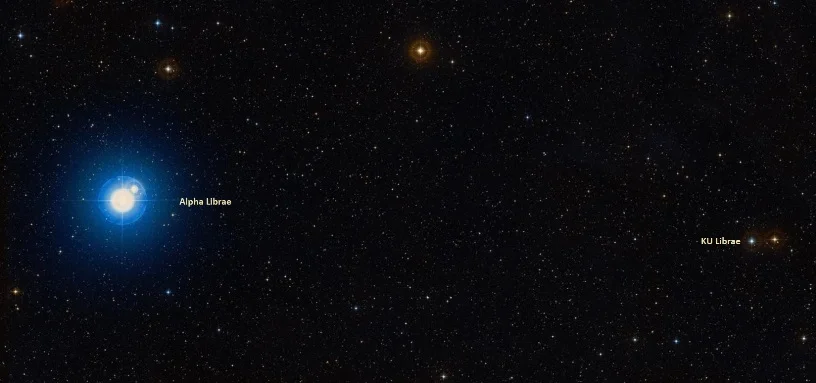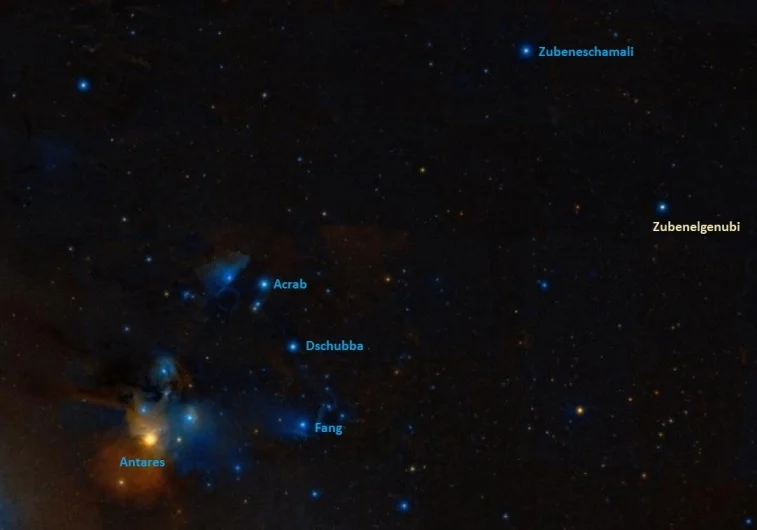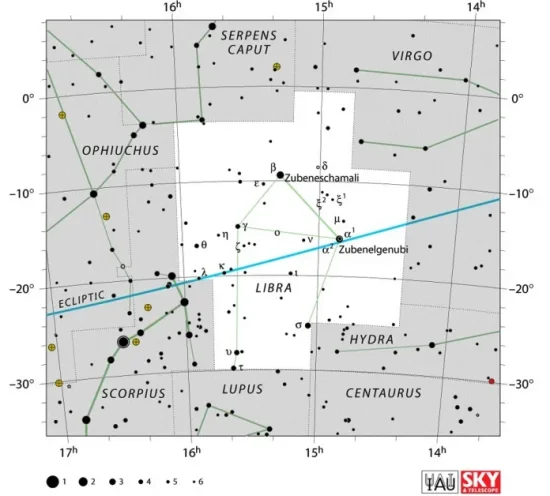Zubenelgenubi, Alpha2 Librae (α2 Lib), is a spectroscopic binary star located in the constellation Libra. It is the brighter component of the Alpha Librae system, which also contains Alpha1 Librae, another spectroscopic binary. With an apparent magnitude of 2.741, Zubenelgenubi is the second brightest point of light in Libra, after Zubeneschamali. It lies at an approximate distance of 75.8 light years from Earth.
Star system
Alpha Librae is a quadruple star system composed of two spectroscopic binary stars, designated Alpha1 Librae (Alpha Librae B) and Alpha2 Librae (Alpha Librae A). The two pairs are separated by about 5,400 astronomical units and have an orbital period of over 200,000 years. The angular distance between them is 231’’ (3’51’’).
Alpha1 Librae has an apparent magnitude of 5.153 and lies at a distance of 74.8 light years from Earth, while the brighter Alpha2, formally known as Zubenelgenubi, shines at magnitude 2.741 and lies 75.8 light years away.

Zubenelgenubi (Alpha Librae), image: Wikisky
The primary component, Alpha2 Librae (Alpha Librae A), has the stellar classification kA2hA5mA4 IV-V. It is a double-lined spectroscopic binary star consisting of a fast-spinning class A star and a more slowly spinning late-A or early F-type companion. The two stars orbit each other with a period of 70.34 days from a distance of about 0.51 astronomical units. Their maximum projected separation is between 20 and 25 milliarcseconds.
The two components of Alpha1 Librae orbit each other with a period of 5,870 days and are separated by 0.383 arcseconds. This translates into a physical distance of about 10 light years. The system is a single-lined spectroscopic binary with the stellar classification F3 V. The primary component has an effective temperature of 6,653 K and a projected rotational velocity of 5.95 km/s. The system’s estimated age is 1.1 billion years.

The Alpha Librae star system, image: Wikisky
The Alpha Librae system may have another component. The class G main sequence star KU Librae (HD 128987) has a similar proper motion and radial velocity as the four components of Alpha Librae. It is separated from the Alpha Librae system by 2.6 degrees. The physical distance between them is 1.01 parsec (3.29 light years), which is close enough for the star to be gravitationally bound to the system. However, KU Librae has a significantly different metal enrichment, which makes it unlikely that it is part of the same star system. It may have, however, originated in the same molecular cloud as the components of Alpha Librae.

Alpha Librae and KU Librae, image: Wikisky
Facts
Zubenelgenubi is one of the 58 bright stars selected for use in navigation. It is the only navigational star in Libra. It belongs to a group of 13 equatorial navigational stars of the western hemisphere. Other bright stars in this group are Markab and Enif in the constellation Pegasus, Altair in Aquila, Rasalhague and Sabik in Ophiuchus, Alphecca in Corona Borealis, Arcturus in Boötes, Fomalhaut in Piscis Austrinus, Nunki in Sagittarius, Antares in Scorpius, Spica in Virgo, and Gienah in Corvus.
Zubenelgenubi lies only 0.33 degrees north of the ecliptic and can be occulted by the Moon. It is also occulted by planets, but this only happens very rarely. The last occultation by a planet (Venus) was observed on October 25, 1947. The next one, by Mercury, is expected to take place on November 10, 2052. Both Alpha2 and Alpha1 Librae are occulted by the Sun from about November 7 to 9 every year.
On average, Zubenelgenubi is the 105th brightest star in the sky. With a combined apparent magnitude of 2.64, the star system is only slightly fainter than Ascella in the constellation Sagittarius, Zubeneschamali in Libra, and Unukalhai in Serpens. It is about as bright as Sheratan in Aries and it just outshines Phact in Columba, Mahasim in Auriga, Kraz in Corvus, and Ruchbah in Cassiopeia.
Name
The name Zubenelgenubi (pronunciation: /zuːˌbɛnɛldʒɪˈnuːbi/) comes from the Arabic al-zubānā al-janūbiyy, meaning “the southern claw.” It refers to the star’s position in the constellation Scorpius. Libra stars once outlined the claws of Scorpius, before Libra was recognized as a separate constellation. The northern claw was represented by the brighter Zubeneschamali. Zubenelgenubi was the traditional name for the whole Alpha Librae star system. It has also been spelled Zuben Elgenubi.
Alpha Librae was also traditionally known as Kiffa Australis. Kiffa is derived the Arabic al-kiffah al-janubiyyah, meaning “the southern pan (of the scales)” and australis is Latin for “southern.” The Latin versions of the name were Lanx Australis and Lanx Meridionalis, both meaning “the southern tray (of the scales).” The star was also known as Vaznegenubi or Al Wazn al Janubiyyah, “the southern weight.”
The name Zubenelgenubi was approved by the International Astronomical Union’s (IAU) Working Group on Star Names (WGSN) on August 21, 2016. It formally applies only to the component Alpha Librae Aa (Alpha2 Librae A).
The Chinese know Zubenelgenubi as 氐宿一 (Dī Xiù yī), the First Star of Root. The Chinese Root asterism is formed by Zubenelgenubi with Zubeneschamali (Beta Librae), Iota1 Librae, and Zubenelhakrabi (Gamma Librae). It represents the chest of the Azure Dragon.
Location
Zubenelgenubi is quite easy to find because it lies next to a prominent asterism that outlines the claws of Scorpius, formed by three bright stars west of Antares: Acrab, Dschubba and Fang. Zubenelgenubi and Zubeneschamali appear as the extended claws of the scorpion. The best time of year to observe Zubenelgenubi is in the late spring and early summer. In early May, the star is visible throughout the night as it rises at sunset and sets at dawn.

Zubenelgenubi location, image: Wikisky
Constellation
Zubenelgenubi is located in the constellation Libra. Libra is the 29th constellation in size, stretching across 538 square degrees between the constellations Scorpius, Virgo, Serpens, Ophiuchus, Centaurus, Hydra, and Lupus. Like other constellations in the zodiac family, it is one of the Greek constellations, first listed by the Greek astronomer Ptolemy in the 2nd century CE. While its scales asterism is visible from less light-polluted areas, the constellation itself does not really stand out, since it only contains two stars brighter than magnitude 3.00: Zubeneschamali and Zubenelgenubi.

Libra constellation map by IAU and Sky&Telescope magazine
Interesting stars in Libra include Methuselah star (HD 140283), one of the oldest stars known, with an age of about 14.46 billion years, the red dwarf Gliese 581, which hosts the first Earth-like exoplanet discovered orbiting in its star’s habitable zone, the Algol-type variable Delta Librae, and the multiple star system Iota1 Librae.
Notable deep sky objects in the constellation include the barred spiral galaxies NGC 5792 and NGC 5885, and the large globular cluster NGC 5892 (12.6 arcminutes in diameter).
The best time of year to see the stars and deep sky objects in Libra is during the month of June, when the constellation is prominent in the evening sky. Libra is visible in its entirety from locations between the latitudes 65° N and -90° S.
The 10 brightest stars in Libra are Zubeneschamali (Beta Lib, mag. 2.61), Zubenelgenubi (Alpha Lib, mag. 2.741), Brachium (Sigma Lib, mag. 3.29), Upsilon Librae (mag. 3.628), Tau Librae (mag. 3.68), Zubenelhakrabi (Gamma Lib, mag. 3.91), Theta Librae (mag. 4.136), 16 Librae (mag. 4.49), Iota1 Librae (mag. 4.54), and 37 Librae (mag. 4.61).
Zubenelgenubi – Alpha2 Librae (Alpha Librae A)
| Spectral class | kA2hA5mA4 IV-V |
| U-B colour index | +0.10 |
| B-V colour index | +0.15 |
| Apparent magnitude | 2.741 |
| Distance | 75.8 ± 0.3 light years (23.2 ± 0.1 parsecs) |
| Parallax | 43.03 ± 0.19 mas |
| Proper motion | RA: -105.68 mas/yr |
| Dec.: -68.40 mas/yr | |
| Temperature | 8,128 K |
| Surface gravity | 3.91 cgs |
| Constellation | Libra |
| Right ascension | 14h 50m 52.71309s |
| Declination | –16° 02′ 30.3955″ |
| Names and designations | Zubenelgenubi, Alpha2 Librae, α2 Lib, Alpha Librae A, 9 Librae, HD 130841, HR 5531, HIP 72622, BD–15 3966, SAO 158840, FK5 548, GC 19975, GCRV 8623, PPM 229372, IRAS 14481-1550, 2MASS J14505274-1602302, JP11 2543, PLX 3351.00, UBV 12928, TYC 6155-1210-1 , CCDM J14508-1602A, IDS 14453-1537 A, WDS J14509-1603Aa,Ab, WDS J14509-1603A |
Alpha1 Librae (Alpha Librae B)
| Spectral class | F3 V |
| U-B colour index | –0.02 |
| B-V colour index | +0.39 |
| Apparent magnitude | 5.153 |
| Absolute magnitude | 3.35 |
| Distance | 74.9 ± 0.7 light years (23.0 ± 0.2 parsecs) |
| Parallax | 42.7927 ± 0.1965 mas |
| Radial velocity | -23.47 km/s |
| Proper motion | RA: -76.220 mas/yr |
| Dec.: -63.085 mas/yr | |
| Temperature | 6,653 K |
| Metallicity | -0.07 dex |
| Age | 1.1 billion years (0.3 – 1.7 billion years) |
| Rotational velocity | 5.95 km/s |
| Surface gravity | 4.25 cgs |
| Constellation | Libra |
| Right ascension | 14h 50m 41. 1746746757s |
| Declination | –15° 59′ 50. 028744741″ |
| Names and designations | Alpha1 Librae, α1 Lib, Alpha Librae B, 8 Librae, HD 130819, HR 5530, HIP 72603, BD–15 3965, SAO 158836, FK5 1387, GC 19970, GCRV 8619, PPM 229365, IRAS 14479-1547, 2MASS J14504122-1559498, JP11 2542, PLX 3350.00, UBV 12927, TYC 6155-1209-1, Gaia DR2 6309706875115188224, CCDM J14508-1602B, IDS 14453-1537 B, WDS J14509-1603Ba,Bb, WDS J14509-1603B |